Report on Quality Physical Environment in Early Education (HBEC4303)
VerifiedAdded on 2023/04/19
|16
|4423
|282
Report
AI Summary
This report delves into the significance of a quality physical environment in early childhood education, emphasizing the crucial role it plays in fostering children's development. It explores the key characteristics of a well-designed early childhood setting, including the organization of space, the provision of diverse learning areas, and the availability of age-appropriate materials. The report highlights the importance of creating a safe and secure environment, discussing how this impacts children's cognitive and emotional growth. It examines strategies for ensuring safety, organizing learning materials, and promoting positive interactions. Furthermore, the report emphasizes the link between a secure environment and a child's ability to develop trust, build relationships, and cultivate a sense of belonging, which is essential for their overall well-being. The report concludes by underscoring the importance of teachers and school management in creating a supportive and stimulating environment that promotes children's social, emotional, and cognitive development.
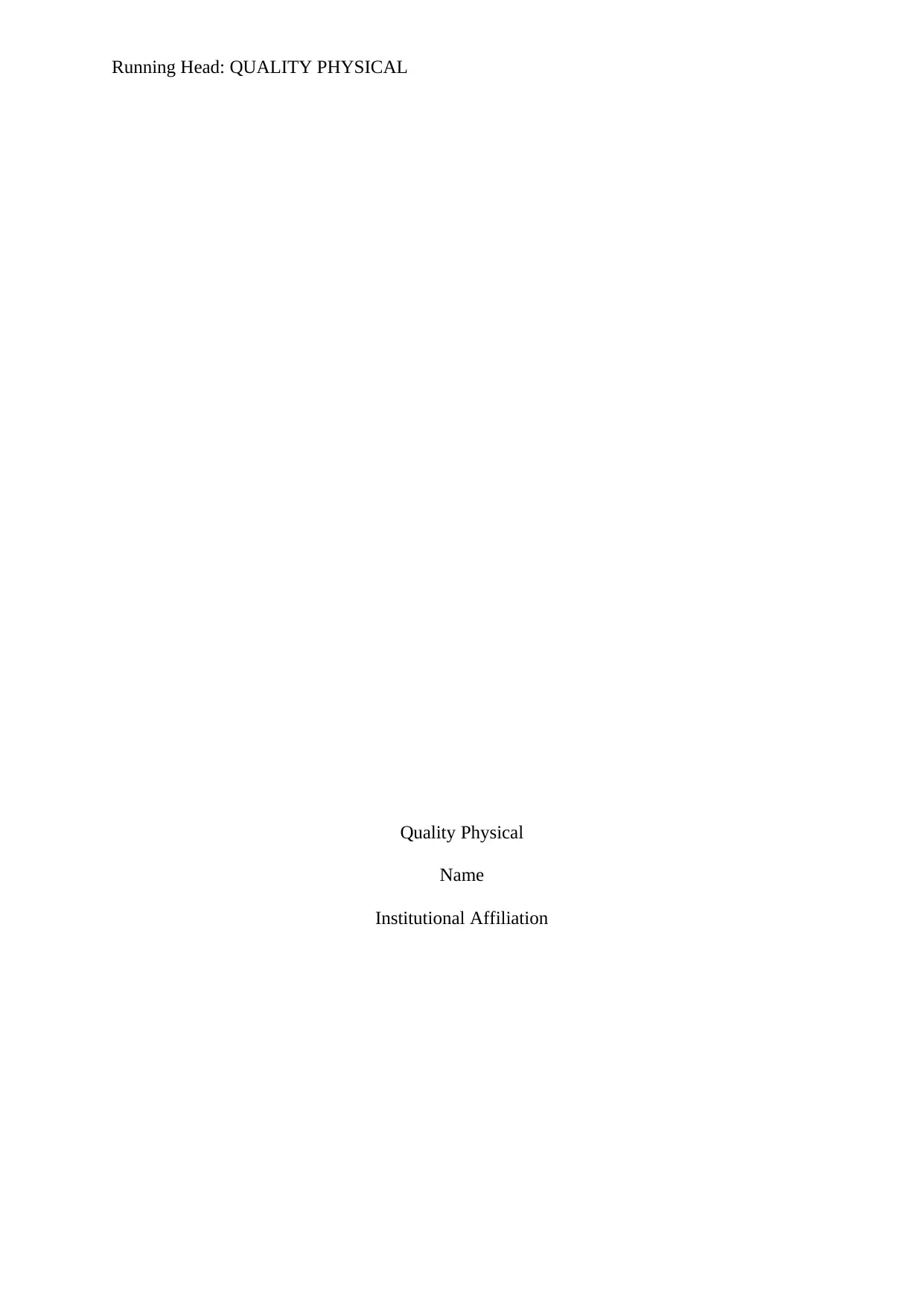
Running Head: QUALITY PHYSICAL
Quality Physical
Name
Institutional Affiliation
Quality Physical
Name
Institutional Affiliation
Paraphrase This Document
Need a fresh take? Get an instant paraphrase of this document with our AI Paraphraser
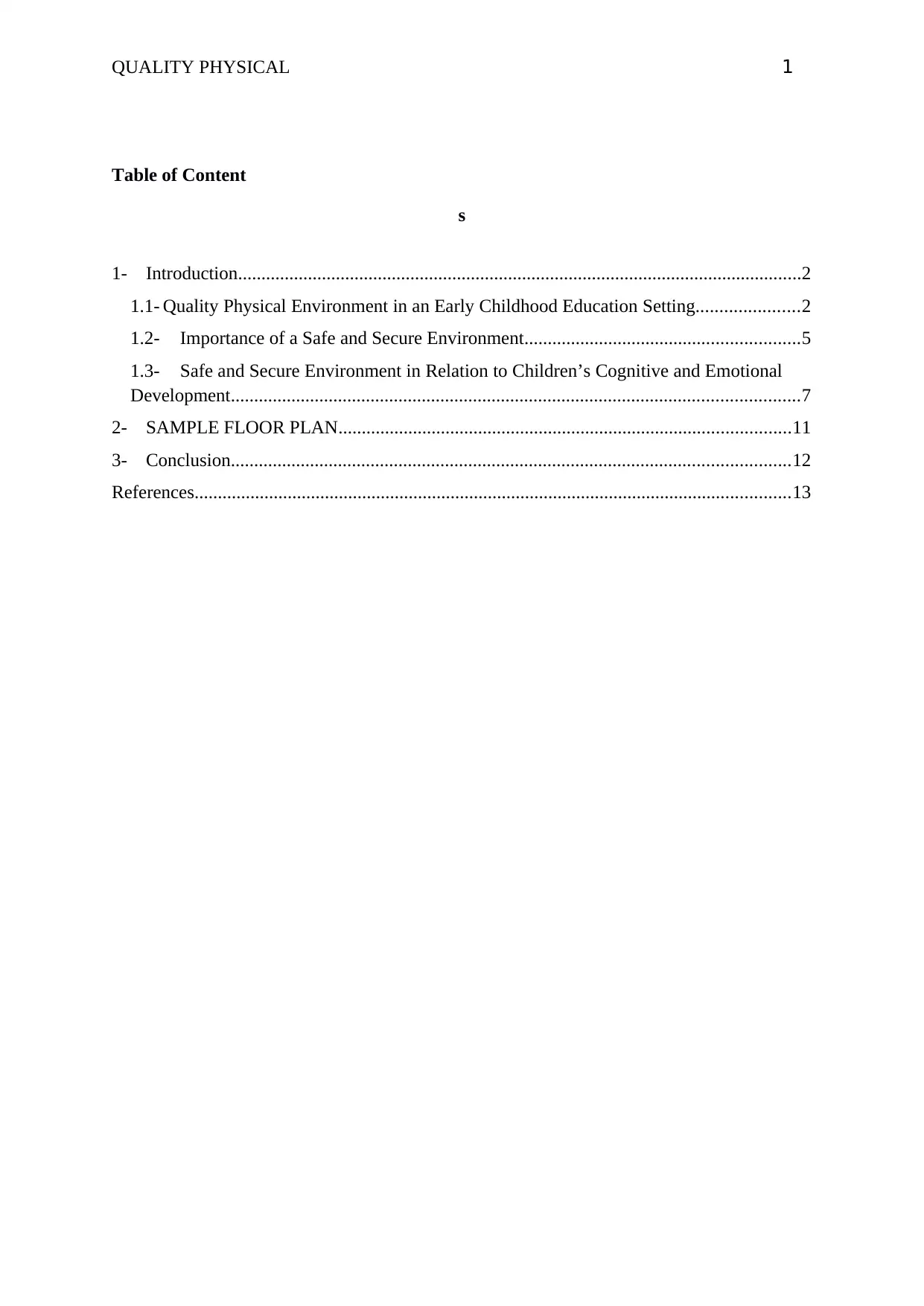
QUALITY PHYSICAL 1
Table of Content
s
1- Introduction.........................................................................................................................2
1.1- Quality Physical Environment in an Early Childhood Education Setting......................2
1.2- Importance of a Safe and Secure Environment...........................................................5
1.3- Safe and Secure Environment in Relation to Children’s Cognitive and Emotional
Development..........................................................................................................................7
2- SAMPLE FLOOR PLAN.................................................................................................11
3- Conclusion........................................................................................................................12
References................................................................................................................................13
Table of Content
s
1- Introduction.........................................................................................................................2
1.1- Quality Physical Environment in an Early Childhood Education Setting......................2
1.2- Importance of a Safe and Secure Environment...........................................................5
1.3- Safe and Secure Environment in Relation to Children’s Cognitive and Emotional
Development..........................................................................................................................7
2- SAMPLE FLOOR PLAN.................................................................................................11
3- Conclusion........................................................................................................................12
References................................................................................................................................13
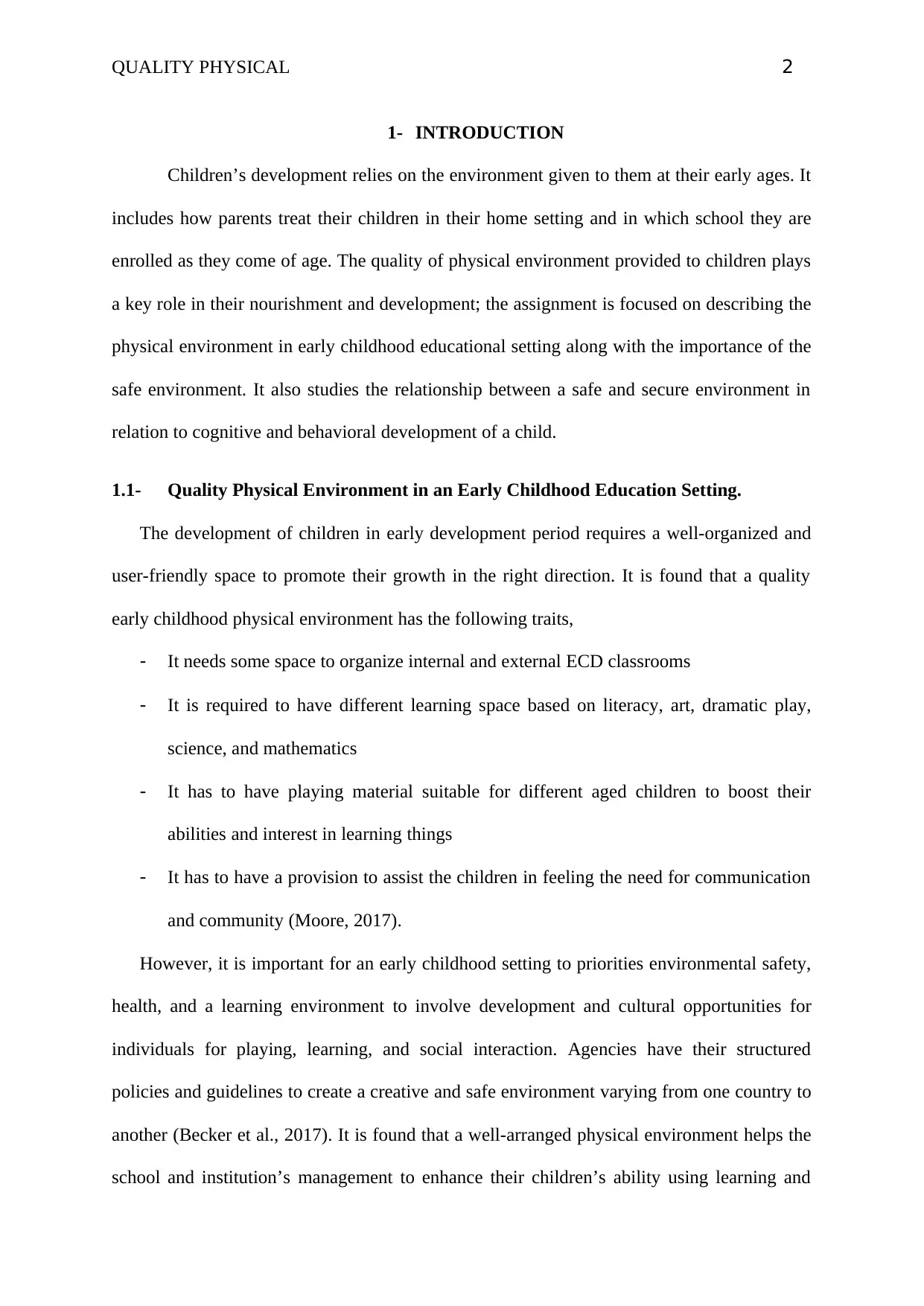
QUALITY PHYSICAL 2
1- INTRODUCTION
Children’s development relies on the environment given to them at their early ages. It
includes how parents treat their children in their home setting and in which school they are
enrolled as they come of age. The quality of physical environment provided to children plays
a key role in their nourishment and development; the assignment is focused on describing the
physical environment in early childhood educational setting along with the importance of the
safe environment. It also studies the relationship between a safe and secure environment in
relation to cognitive and behavioral development of a child.
1.1- Quality Physical Environment in an Early Childhood Education Setting.
The development of children in early development period requires a well-organized and
user-friendly space to promote their growth in the right direction. It is found that a quality
early childhood physical environment has the following traits,
- It needs some space to organize internal and external ECD classrooms
- It is required to have different learning space based on literacy, art, dramatic play,
science, and mathematics
- It has to have playing material suitable for different aged children to boost their
abilities and interest in learning things
- It has to have a provision to assist the children in feeling the need for communication
and community (Moore, 2017).
However, it is important for an early childhood setting to priorities environmental safety,
health, and a learning environment to involve development and cultural opportunities for
individuals for playing, learning, and social interaction. Agencies have their structured
policies and guidelines to create a creative and safe environment varying from one country to
another (Becker et al., 2017). It is found that a well-arranged physical environment helps the
school and institution’s management to enhance their children’s ability using learning and
1- INTRODUCTION
Children’s development relies on the environment given to them at their early ages. It
includes how parents treat their children in their home setting and in which school they are
enrolled as they come of age. The quality of physical environment provided to children plays
a key role in their nourishment and development; the assignment is focused on describing the
physical environment in early childhood educational setting along with the importance of the
safe environment. It also studies the relationship between a safe and secure environment in
relation to cognitive and behavioral development of a child.
1.1- Quality Physical Environment in an Early Childhood Education Setting.
The development of children in early development period requires a well-organized and
user-friendly space to promote their growth in the right direction. It is found that a quality
early childhood physical environment has the following traits,
- It needs some space to organize internal and external ECD classrooms
- It is required to have different learning space based on literacy, art, dramatic play,
science, and mathematics
- It has to have playing material suitable for different aged children to boost their
abilities and interest in learning things
- It has to have a provision to assist the children in feeling the need for communication
and community (Moore, 2017).
However, it is important for an early childhood setting to priorities environmental safety,
health, and a learning environment to involve development and cultural opportunities for
individuals for playing, learning, and social interaction. Agencies have their structured
policies and guidelines to create a creative and safe environment varying from one country to
another (Becker et al., 2017). It is found that a well-arranged physical environment helps the
school and institution’s management to enhance their children’s ability using learning and
⊘ This is a preview!⊘
Do you want full access?
Subscribe today to unlock all pages.

Trusted by 1+ million students worldwide
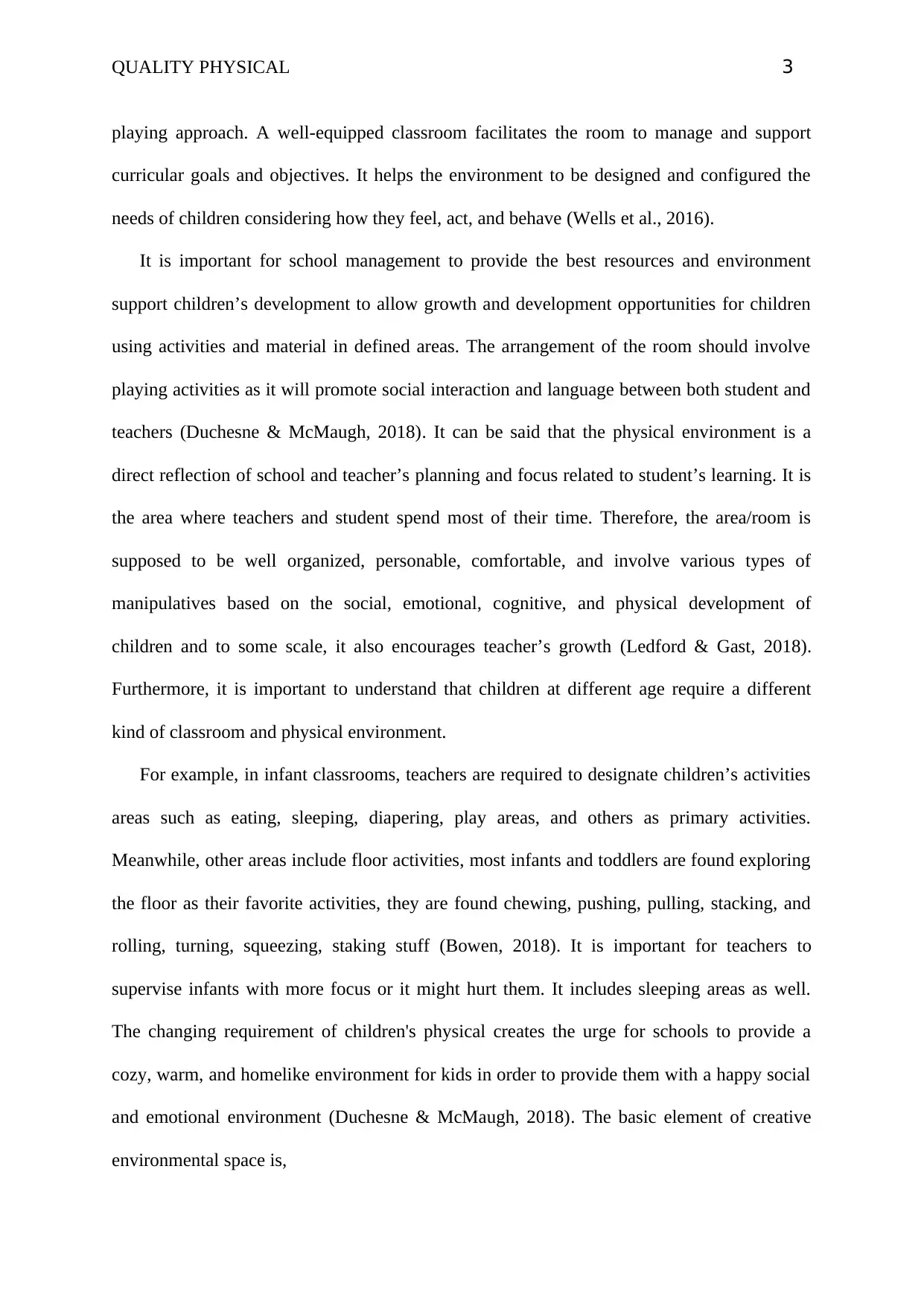
QUALITY PHYSICAL 3
playing approach. A well-equipped classroom facilitates the room to manage and support
curricular goals and objectives. It helps the environment to be designed and configured the
needs of children considering how they feel, act, and behave (Wells et al., 2016).
It is important for school management to provide the best resources and environment
support children’s development to allow growth and development opportunities for children
using activities and material in defined areas. The arrangement of the room should involve
playing activities as it will promote social interaction and language between both student and
teachers (Duchesne & McMaugh, 2018). It can be said that the physical environment is a
direct reflection of school and teacher’s planning and focus related to student’s learning. It is
the area where teachers and student spend most of their time. Therefore, the area/room is
supposed to be well organized, personable, comfortable, and involve various types of
manipulatives based on the social, emotional, cognitive, and physical development of
children and to some scale, it also encourages teacher’s growth (Ledford & Gast, 2018).
Furthermore, it is important to understand that children at different age require a different
kind of classroom and physical environment.
For example, in infant classrooms, teachers are required to designate children’s activities
areas such as eating, sleeping, diapering, play areas, and others as primary activities.
Meanwhile, other areas include floor activities, most infants and toddlers are found exploring
the floor as their favorite activities, they are found chewing, pushing, pulling, stacking, and
rolling, turning, squeezing, staking stuff (Bowen, 2018). It is important for teachers to
supervise infants with more focus or it might hurt them. It includes sleeping areas as well.
The changing requirement of children's physical creates the urge for schools to provide a
cozy, warm, and homelike environment for kids in order to provide them with a happy social
and emotional environment (Duchesne & McMaugh, 2018). The basic element of creative
environmental space is,
playing approach. A well-equipped classroom facilitates the room to manage and support
curricular goals and objectives. It helps the environment to be designed and configured the
needs of children considering how they feel, act, and behave (Wells et al., 2016).
It is important for school management to provide the best resources and environment
support children’s development to allow growth and development opportunities for children
using activities and material in defined areas. The arrangement of the room should involve
playing activities as it will promote social interaction and language between both student and
teachers (Duchesne & McMaugh, 2018). It can be said that the physical environment is a
direct reflection of school and teacher’s planning and focus related to student’s learning. It is
the area where teachers and student spend most of their time. Therefore, the area/room is
supposed to be well organized, personable, comfortable, and involve various types of
manipulatives based on the social, emotional, cognitive, and physical development of
children and to some scale, it also encourages teacher’s growth (Ledford & Gast, 2018).
Furthermore, it is important to understand that children at different age require a different
kind of classroom and physical environment.
For example, in infant classrooms, teachers are required to designate children’s activities
areas such as eating, sleeping, diapering, play areas, and others as primary activities.
Meanwhile, other areas include floor activities, most infants and toddlers are found exploring
the floor as their favorite activities, they are found chewing, pushing, pulling, stacking, and
rolling, turning, squeezing, staking stuff (Bowen, 2018). It is important for teachers to
supervise infants with more focus or it might hurt them. It includes sleeping areas as well.
The changing requirement of children's physical creates the urge for schools to provide a
cozy, warm, and homelike environment for kids in order to provide them with a happy social
and emotional environment (Duchesne & McMaugh, 2018). The basic element of creative
environmental space is,
Paraphrase This Document
Need a fresh take? Get an instant paraphrase of this document with our AI Paraphraser
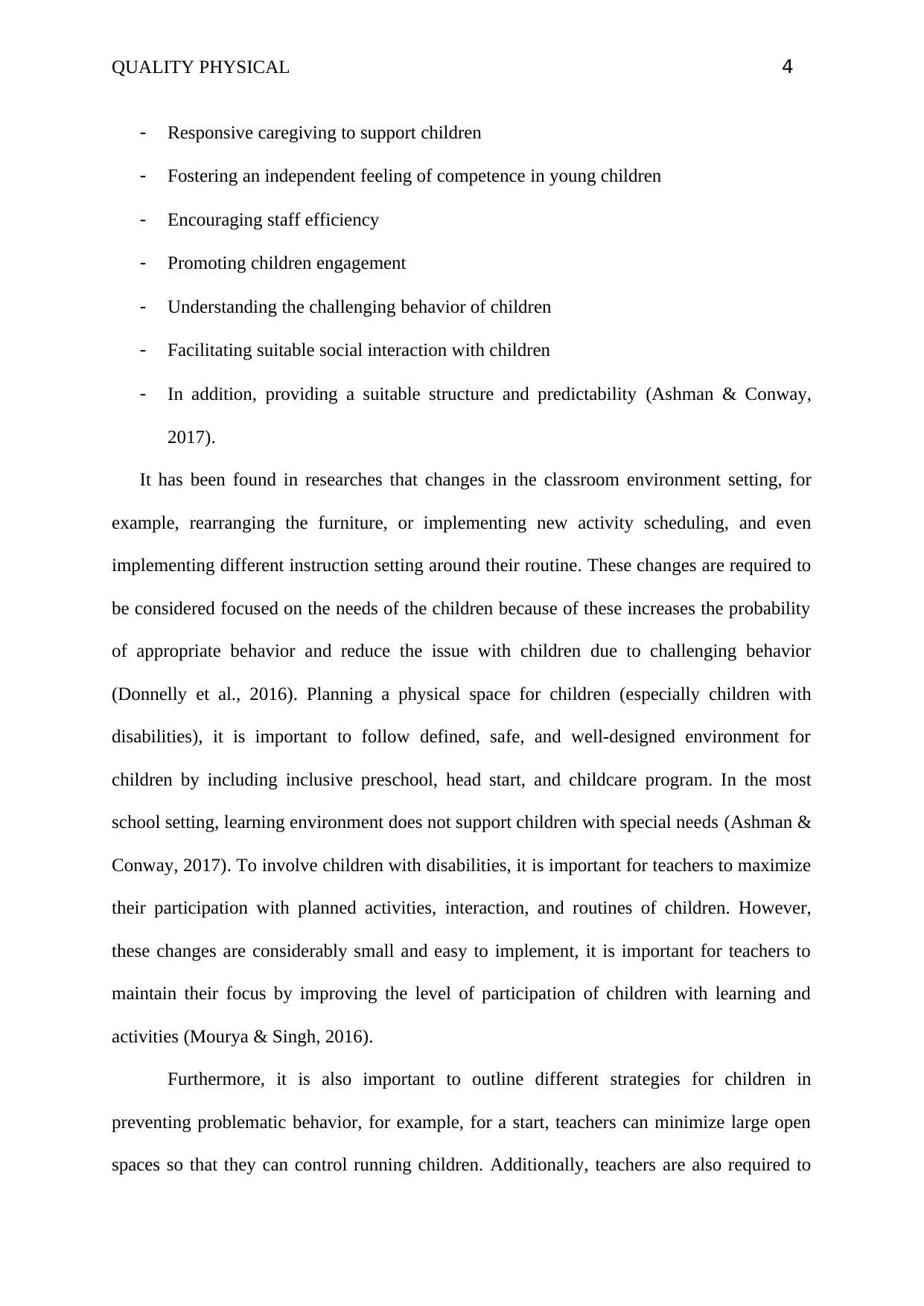
QUALITY PHYSICAL 4
- Responsive caregiving to support children
- Fostering an independent feeling of competence in young children
- Encouraging staff efficiency
- Promoting children engagement
- Understanding the challenging behavior of children
- Facilitating suitable social interaction with children
- In addition, providing a suitable structure and predictability (Ashman & Conway,
2017).
It has been found in researches that changes in the classroom environment setting, for
example, rearranging the furniture, or implementing new activity scheduling, and even
implementing different instruction setting around their routine. These changes are required to
be considered focused on the needs of the children because of these increases the probability
of appropriate behavior and reduce the issue with children due to challenging behavior
(Donnelly et al., 2016). Planning a physical space for children (especially children with
disabilities), it is important to follow defined, safe, and well-designed environment for
children by including inclusive preschool, head start, and childcare program. In the most
school setting, learning environment does not support children with special needs (Ashman &
Conway, 2017). To involve children with disabilities, it is important for teachers to maximize
their participation with planned activities, interaction, and routines of children. However,
these changes are considerably small and easy to implement, it is important for teachers to
maintain their focus by improving the level of participation of children with learning and
activities (Mourya & Singh, 2016).
Furthermore, it is also important to outline different strategies for children in
preventing problematic behavior, for example, for a start, teachers can minimize large open
spaces so that they can control running children. Additionally, teachers are also required to
- Responsive caregiving to support children
- Fostering an independent feeling of competence in young children
- Encouraging staff efficiency
- Promoting children engagement
- Understanding the challenging behavior of children
- Facilitating suitable social interaction with children
- In addition, providing a suitable structure and predictability (Ashman & Conway,
2017).
It has been found in researches that changes in the classroom environment setting, for
example, rearranging the furniture, or implementing new activity scheduling, and even
implementing different instruction setting around their routine. These changes are required to
be considered focused on the needs of the children because of these increases the probability
of appropriate behavior and reduce the issue with children due to challenging behavior
(Donnelly et al., 2016). Planning a physical space for children (especially children with
disabilities), it is important to follow defined, safe, and well-designed environment for
children by including inclusive preschool, head start, and childcare program. In the most
school setting, learning environment does not support children with special needs (Ashman &
Conway, 2017). To involve children with disabilities, it is important for teachers to maximize
their participation with planned activities, interaction, and routines of children. However,
these changes are considerably small and easy to implement, it is important for teachers to
maintain their focus by improving the level of participation of children with learning and
activities (Mourya & Singh, 2016).
Furthermore, it is also important to outline different strategies for children in
preventing problematic behavior, for example, for a start, teachers can minimize large open
spaces so that they can control running children. Additionally, teachers are also required to
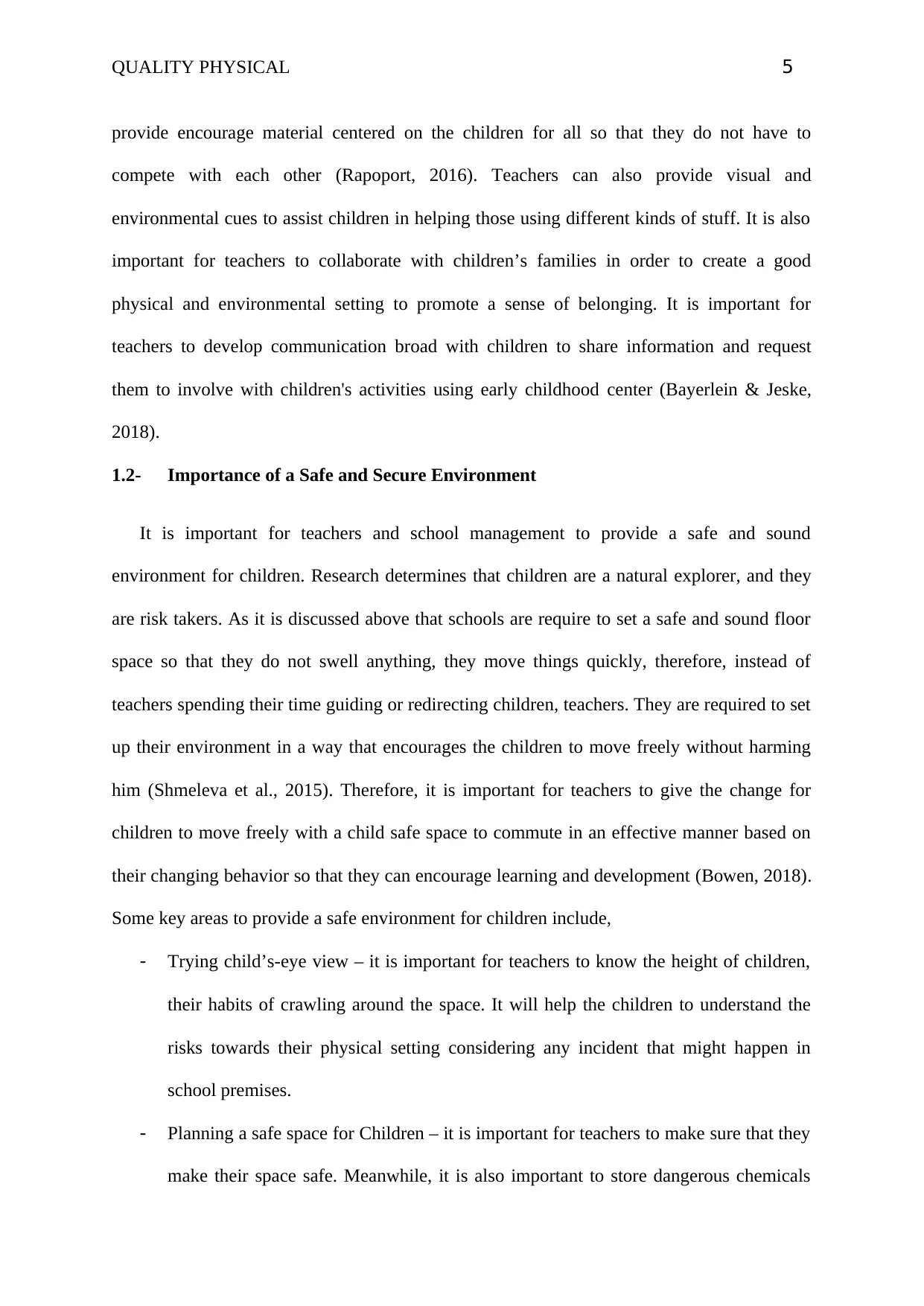
QUALITY PHYSICAL 5
provide encourage material centered on the children for all so that they do not have to
compete with each other (Rapoport, 2016). Teachers can also provide visual and
environmental cues to assist children in helping those using different kinds of stuff. It is also
important for teachers to collaborate with children’s families in order to create a good
physical and environmental setting to promote a sense of belonging. It is important for
teachers to develop communication broad with children to share information and request
them to involve with children's activities using early childhood center (Bayerlein & Jeske,
2018).
1.2- Importance of a Safe and Secure Environment
It is important for teachers and school management to provide a safe and sound
environment for children. Research determines that children are a natural explorer, and they
are risk takers. As it is discussed above that schools are require to set a safe and sound floor
space so that they do not swell anything, they move things quickly, therefore, instead of
teachers spending their time guiding or redirecting children, teachers. They are required to set
up their environment in a way that encourages the children to move freely without harming
him (Shmeleva et al., 2015). Therefore, it is important for teachers to give the change for
children to move freely with a child safe space to commute in an effective manner based on
their changing behavior so that they can encourage learning and development (Bowen, 2018).
Some key areas to provide a safe environment for children include,
- Trying child’s-eye view – it is important for teachers to know the height of children,
their habits of crawling around the space. It will help the children to understand the
risks towards their physical setting considering any incident that might happen in
school premises.
- Planning a safe space for Children – it is important for teachers to make sure that they
make their space safe. Meanwhile, it is also important to store dangerous chemicals
provide encourage material centered on the children for all so that they do not have to
compete with each other (Rapoport, 2016). Teachers can also provide visual and
environmental cues to assist children in helping those using different kinds of stuff. It is also
important for teachers to collaborate with children’s families in order to create a good
physical and environmental setting to promote a sense of belonging. It is important for
teachers to develop communication broad with children to share information and request
them to involve with children's activities using early childhood center (Bayerlein & Jeske,
2018).
1.2- Importance of a Safe and Secure Environment
It is important for teachers and school management to provide a safe and sound
environment for children. Research determines that children are a natural explorer, and they
are risk takers. As it is discussed above that schools are require to set a safe and sound floor
space so that they do not swell anything, they move things quickly, therefore, instead of
teachers spending their time guiding or redirecting children, teachers. They are required to set
up their environment in a way that encourages the children to move freely without harming
him (Shmeleva et al., 2015). Therefore, it is important for teachers to give the change for
children to move freely with a child safe space to commute in an effective manner based on
their changing behavior so that they can encourage learning and development (Bowen, 2018).
Some key areas to provide a safe environment for children include,
- Trying child’s-eye view – it is important for teachers to know the height of children,
their habits of crawling around the space. It will help the children to understand the
risks towards their physical setting considering any incident that might happen in
school premises.
- Planning a safe space for Children – it is important for teachers to make sure that they
make their space safe. Meanwhile, it is also important to store dangerous chemicals
⊘ This is a preview!⊘
Do you want full access?
Subscribe today to unlock all pages.

Trusted by 1+ million students worldwide
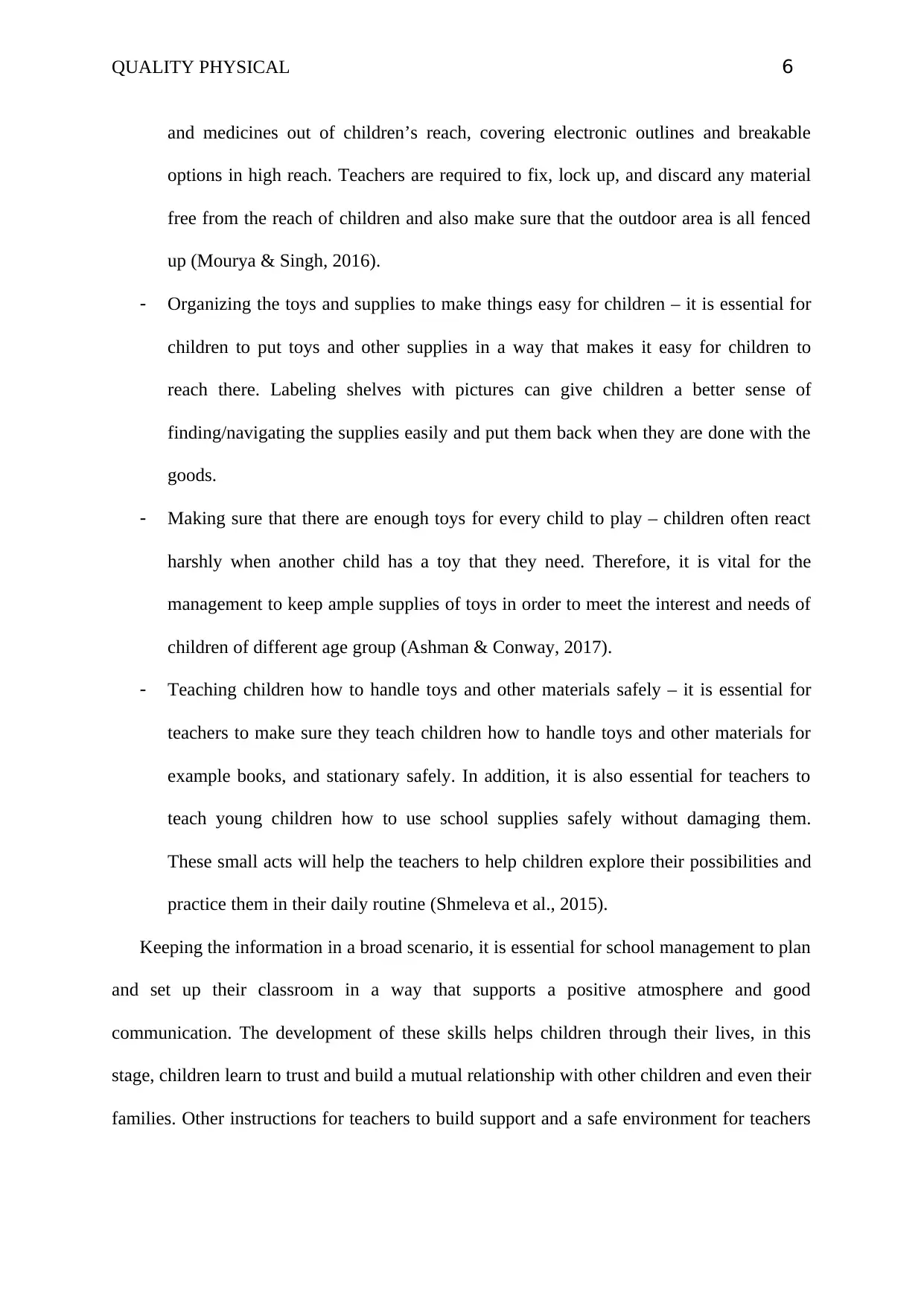
QUALITY PHYSICAL 6
and medicines out of children’s reach, covering electronic outlines and breakable
options in high reach. Teachers are required to fix, lock up, and discard any material
free from the reach of children and also make sure that the outdoor area is all fenced
up (Mourya & Singh, 2016).
- Organizing the toys and supplies to make things easy for children – it is essential for
children to put toys and other supplies in a way that makes it easy for children to
reach there. Labeling shelves with pictures can give children a better sense of
finding/navigating the supplies easily and put them back when they are done with the
goods.
- Making sure that there are enough toys for every child to play – children often react
harshly when another child has a toy that they need. Therefore, it is vital for the
management to keep ample supplies of toys in order to meet the interest and needs of
children of different age group (Ashman & Conway, 2017).
- Teaching children how to handle toys and other materials safely – it is essential for
teachers to make sure they teach children how to handle toys and other materials for
example books, and stationary safely. In addition, it is also essential for teachers to
teach young children how to use school supplies safely without damaging them.
These small acts will help the teachers to help children explore their possibilities and
practice them in their daily routine (Shmeleva et al., 2015).
Keeping the information in a broad scenario, it is essential for school management to plan
and set up their classroom in a way that supports a positive atmosphere and good
communication. The development of these skills helps children through their lives, in this
stage, children learn to trust and build a mutual relationship with other children and even their
families. Other instructions for teachers to build support and a safe environment for teachers
and medicines out of children’s reach, covering electronic outlines and breakable
options in high reach. Teachers are required to fix, lock up, and discard any material
free from the reach of children and also make sure that the outdoor area is all fenced
up (Mourya & Singh, 2016).
- Organizing the toys and supplies to make things easy for children – it is essential for
children to put toys and other supplies in a way that makes it easy for children to
reach there. Labeling shelves with pictures can give children a better sense of
finding/navigating the supplies easily and put them back when they are done with the
goods.
- Making sure that there are enough toys for every child to play – children often react
harshly when another child has a toy that they need. Therefore, it is vital for the
management to keep ample supplies of toys in order to meet the interest and needs of
children of different age group (Ashman & Conway, 2017).
- Teaching children how to handle toys and other materials safely – it is essential for
teachers to make sure they teach children how to handle toys and other materials for
example books, and stationary safely. In addition, it is also essential for teachers to
teach young children how to use school supplies safely without damaging them.
These small acts will help the teachers to help children explore their possibilities and
practice them in their daily routine (Shmeleva et al., 2015).
Keeping the information in a broad scenario, it is essential for school management to plan
and set up their classroom in a way that supports a positive atmosphere and good
communication. The development of these skills helps children through their lives, in this
stage, children learn to trust and build a mutual relationship with other children and even their
families. Other instructions for teachers to build support and a safe environment for teachers
Paraphrase This Document
Need a fresh take? Get an instant paraphrase of this document with our AI Paraphraser
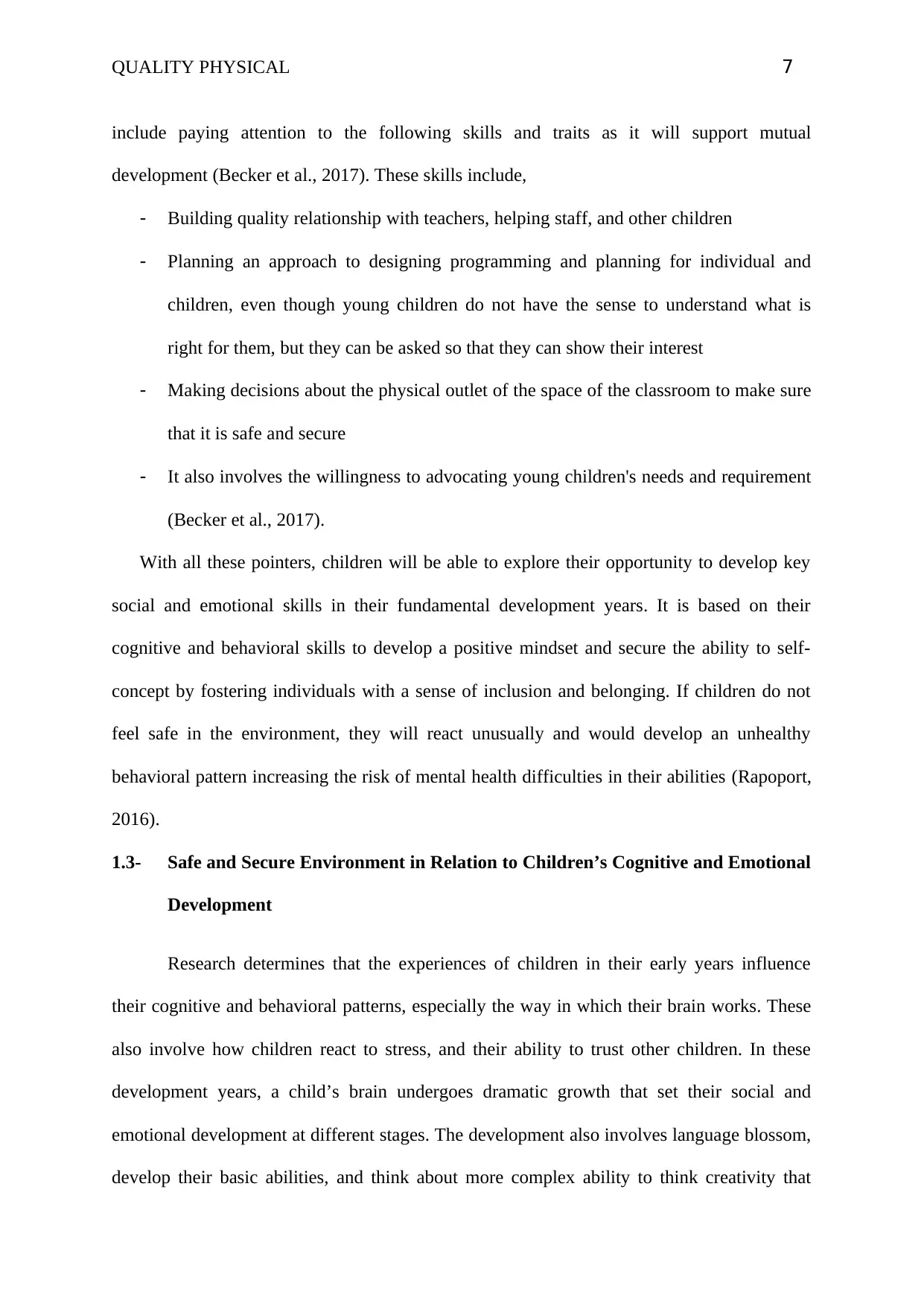
QUALITY PHYSICAL 7
include paying attention to the following skills and traits as it will support mutual
development (Becker et al., 2017). These skills include,
- Building quality relationship with teachers, helping staff, and other children
- Planning an approach to designing programming and planning for individual and
children, even though young children do not have the sense to understand what is
right for them, but they can be asked so that they can show their interest
- Making decisions about the physical outlet of the space of the classroom to make sure
that it is safe and secure
- It also involves the willingness to advocating young children's needs and requirement
(Becker et al., 2017).
With all these pointers, children will be able to explore their opportunity to develop key
social and emotional skills in their fundamental development years. It is based on their
cognitive and behavioral skills to develop a positive mindset and secure the ability to self-
concept by fostering individuals with a sense of inclusion and belonging. If children do not
feel safe in the environment, they will react unusually and would develop an unhealthy
behavioral pattern increasing the risk of mental health difficulties in their abilities (Rapoport,
2016).
1.3- Safe and Secure Environment in Relation to Children’s Cognitive and Emotional
Development
Research determines that the experiences of children in their early years influence
their cognitive and behavioral patterns, especially the way in which their brain works. These
also involve how children react to stress, and their ability to trust other children. In these
development years, a child’s brain undergoes dramatic growth that set their social and
emotional development at different stages. The development also involves language blossom,
develop their basic abilities, and think about more complex ability to think creativity that
include paying attention to the following skills and traits as it will support mutual
development (Becker et al., 2017). These skills include,
- Building quality relationship with teachers, helping staff, and other children
- Planning an approach to designing programming and planning for individual and
children, even though young children do not have the sense to understand what is
right for them, but they can be asked so that they can show their interest
- Making decisions about the physical outlet of the space of the classroom to make sure
that it is safe and secure
- It also involves the willingness to advocating young children's needs and requirement
(Becker et al., 2017).
With all these pointers, children will be able to explore their opportunity to develop key
social and emotional skills in their fundamental development years. It is based on their
cognitive and behavioral skills to develop a positive mindset and secure the ability to self-
concept by fostering individuals with a sense of inclusion and belonging. If children do not
feel safe in the environment, they will react unusually and would develop an unhealthy
behavioral pattern increasing the risk of mental health difficulties in their abilities (Rapoport,
2016).
1.3- Safe and Secure Environment in Relation to Children’s Cognitive and Emotional
Development
Research determines that the experiences of children in their early years influence
their cognitive and behavioral patterns, especially the way in which their brain works. These
also involve how children react to stress, and their ability to trust other children. In these
development years, a child’s brain undergoes dramatic growth that set their social and
emotional development at different stages. The development also involves language blossom,
develop their basic abilities, and think about more complex ability to think creativity that

QUALITY PHYSICAL 8
further support them understand how other feels and how they reach towards the different
situation (Bayerlein & Jeske, 2018). The development aspects of a child’s development are
interconnected, it enhances the children’s ability to explore new information, and how it
influences their ability while interacting with others to control their immediate impulses.
These are based on four elements – physical, emotions, cognitive, and social skills. In case of
social and emotional development standard has changed in a passage of time, it has also
developed the children’s ability to react and interact within their social environment standards
(Ledford & Gast, 2018).
Research determines that social and emotional development of children is complex and
include different areas of growth and development. Some important areas include,
- Temperaments – it determines that way in which a child reaches to a different
situation, to their caregiver, and strangers. A parent and teacher should help a child
understand the importance of close/known people and strangers so that they can react
accordingly.
- Attachment – it is focused on developing the sense of emotion among children that
help the parent and teachers to give a boast of emotions between the children and their
inner circle (Becker et al., 2017).
- Social skills/competence – it is focused on developing the social skills of children so
that they can get along with people rightfully.
- Emotional regulation – It focuses on controlling the children’s ability over their
emotions and their response to different situations (Bowen, 2018).
Evidence shows that approximately 55% of infants display at least one characteristic of a
difficult temperament while growing up. Every child needs extra attention, and this makes it
challenging for the parents to handle their child. In addition, when the same children are
exposed to day-care or pre-nursery classrooms with other children, they begin to grow their
further support them understand how other feels and how they reach towards the different
situation (Bayerlein & Jeske, 2018). The development aspects of a child’s development are
interconnected, it enhances the children’s ability to explore new information, and how it
influences their ability while interacting with others to control their immediate impulses.
These are based on four elements – physical, emotions, cognitive, and social skills. In case of
social and emotional development standard has changed in a passage of time, it has also
developed the children’s ability to react and interact within their social environment standards
(Ledford & Gast, 2018).
Research determines that social and emotional development of children is complex and
include different areas of growth and development. Some important areas include,
- Temperaments – it determines that way in which a child reaches to a different
situation, to their caregiver, and strangers. A parent and teacher should help a child
understand the importance of close/known people and strangers so that they can react
accordingly.
- Attachment – it is focused on developing the sense of emotion among children that
help the parent and teachers to give a boast of emotions between the children and their
inner circle (Becker et al., 2017).
- Social skills/competence – it is focused on developing the social skills of children so
that they can get along with people rightfully.
- Emotional regulation – It focuses on controlling the children’s ability over their
emotions and their response to different situations (Bowen, 2018).
Evidence shows that approximately 55% of infants display at least one characteristic of a
difficult temperament while growing up. Every child needs extra attention, and this makes it
challenging for the parents to handle their child. In addition, when the same children are
exposed to day-care or pre-nursery classrooms with other children, they begin to grow their
⊘ This is a preview!⊘
Do you want full access?
Subscribe today to unlock all pages.

Trusted by 1+ million students worldwide
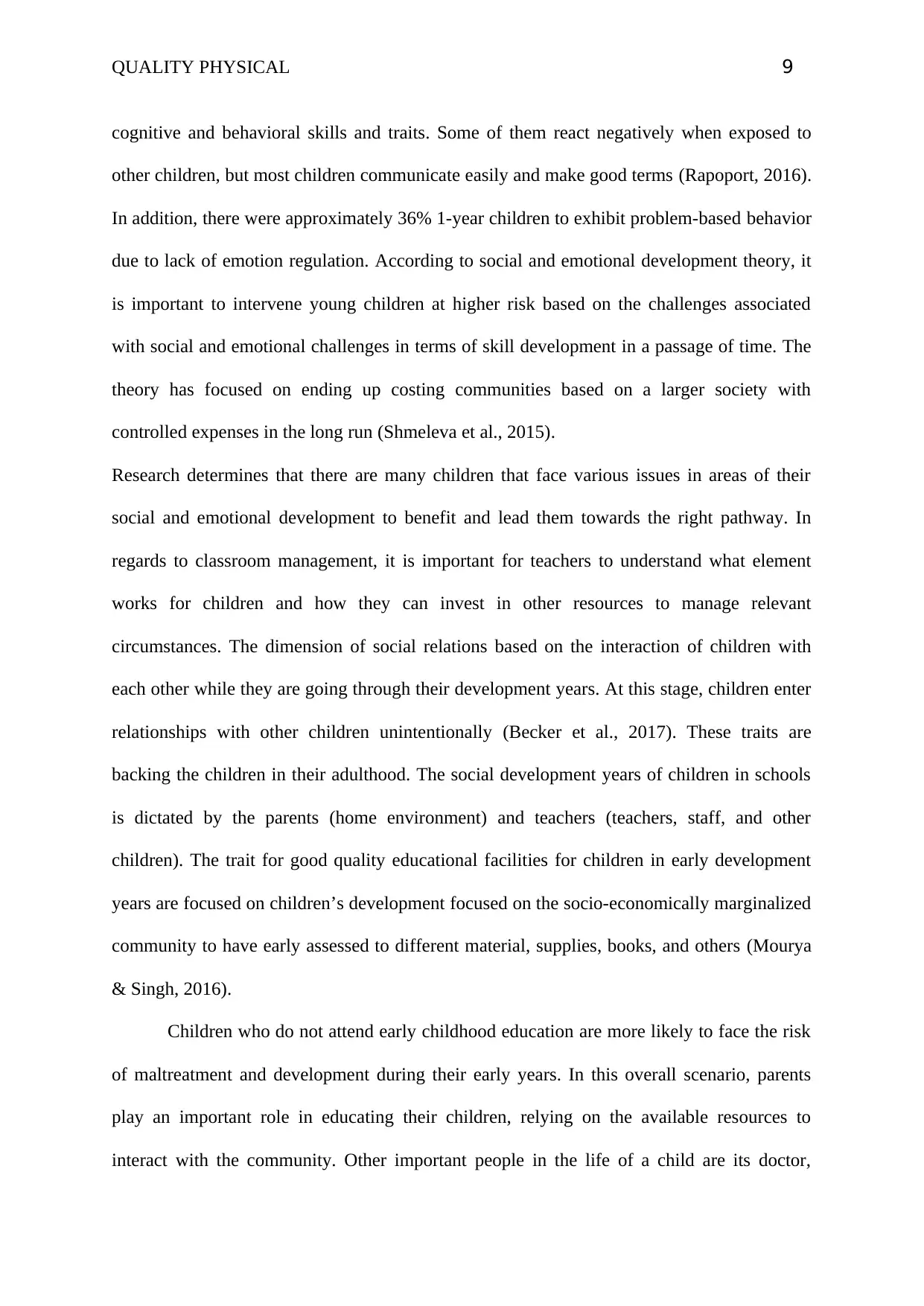
QUALITY PHYSICAL 9
cognitive and behavioral skills and traits. Some of them react negatively when exposed to
other children, but most children communicate easily and make good terms (Rapoport, 2016).
In addition, there were approximately 36% 1-year children to exhibit problem-based behavior
due to lack of emotion regulation. According to social and emotional development theory, it
is important to intervene young children at higher risk based on the challenges associated
with social and emotional challenges in terms of skill development in a passage of time. The
theory has focused on ending up costing communities based on a larger society with
controlled expenses in the long run (Shmeleva et al., 2015).
Research determines that there are many children that face various issues in areas of their
social and emotional development to benefit and lead them towards the right pathway. In
regards to classroom management, it is important for teachers to understand what element
works for children and how they can invest in other resources to manage relevant
circumstances. The dimension of social relations based on the interaction of children with
each other while they are going through their development years. At this stage, children enter
relationships with other children unintentionally (Becker et al., 2017). These traits are
backing the children in their adulthood. The social development years of children in schools
is dictated by the parents (home environment) and teachers (teachers, staff, and other
children). The trait for good quality educational facilities for children in early development
years are focused on children’s development focused on the socio-economically marginalized
community to have early assessed to different material, supplies, books, and others (Mourya
& Singh, 2016).
Children who do not attend early childhood education are more likely to face the risk
of maltreatment and development during their early years. In this overall scenario, parents
play an important role in educating their children, relying on the available resources to
interact with the community. Other important people in the life of a child are its doctor,
cognitive and behavioral skills and traits. Some of them react negatively when exposed to
other children, but most children communicate easily and make good terms (Rapoport, 2016).
In addition, there were approximately 36% 1-year children to exhibit problem-based behavior
due to lack of emotion regulation. According to social and emotional development theory, it
is important to intervene young children at higher risk based on the challenges associated
with social and emotional challenges in terms of skill development in a passage of time. The
theory has focused on ending up costing communities based on a larger society with
controlled expenses in the long run (Shmeleva et al., 2015).
Research determines that there are many children that face various issues in areas of their
social and emotional development to benefit and lead them towards the right pathway. In
regards to classroom management, it is important for teachers to understand what element
works for children and how they can invest in other resources to manage relevant
circumstances. The dimension of social relations based on the interaction of children with
each other while they are going through their development years. At this stage, children enter
relationships with other children unintentionally (Becker et al., 2017). These traits are
backing the children in their adulthood. The social development years of children in schools
is dictated by the parents (home environment) and teachers (teachers, staff, and other
children). The trait for good quality educational facilities for children in early development
years are focused on children’s development focused on the socio-economically marginalized
community to have early assessed to different material, supplies, books, and others (Mourya
& Singh, 2016).
Children who do not attend early childhood education are more likely to face the risk
of maltreatment and development during their early years. In this overall scenario, parents
play an important role in educating their children, relying on the available resources to
interact with the community. Other important people in the life of a child are its doctor,
Paraphrase This Document
Need a fresh take? Get an instant paraphrase of this document with our AI Paraphraser
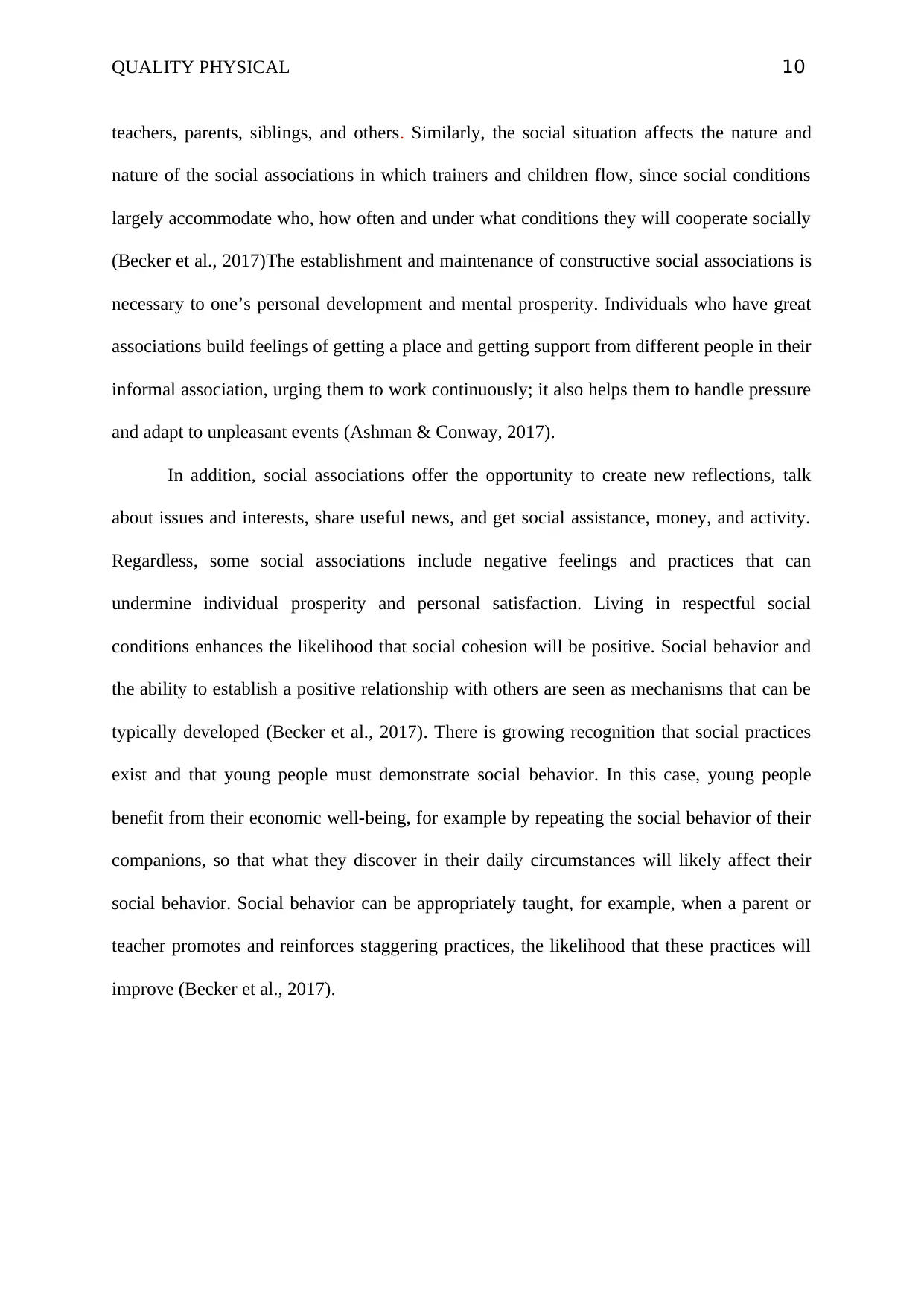
QUALITY PHYSICAL 10
teachers, parents, siblings, and others. Similarly, the social situation affects the nature and
nature of the social associations in which trainers and children flow, since social conditions
largely accommodate who, how often and under what conditions they will cooperate socially
(Becker et al., 2017)The establishment and maintenance of constructive social associations is
necessary to one’s personal development and mental prosperity. Individuals who have great
associations build feelings of getting a place and getting support from different people in their
informal association, urging them to work continuously; it also helps them to handle pressure
and adapt to unpleasant events (Ashman & Conway, 2017).
In addition, social associations offer the opportunity to create new reflections, talk
about issues and interests, share useful news, and get social assistance, money, and activity.
Regardless, some social associations include negative feelings and practices that can
undermine individual prosperity and personal satisfaction. Living in respectful social
conditions enhances the likelihood that social cohesion will be positive. Social behavior and
the ability to establish a positive relationship with others are seen as mechanisms that can be
typically developed (Becker et al., 2017). There is growing recognition that social practices
exist and that young people must demonstrate social behavior. In this case, young people
benefit from their economic well-being, for example by repeating the social behavior of their
companions, so that what they discover in their daily circumstances will likely affect their
social behavior. Social behavior can be appropriately taught, for example, when a parent or
teacher promotes and reinforces staggering practices, the likelihood that these practices will
improve (Becker et al., 2017).
teachers, parents, siblings, and others. Similarly, the social situation affects the nature and
nature of the social associations in which trainers and children flow, since social conditions
largely accommodate who, how often and under what conditions they will cooperate socially
(Becker et al., 2017)The establishment and maintenance of constructive social associations is
necessary to one’s personal development and mental prosperity. Individuals who have great
associations build feelings of getting a place and getting support from different people in their
informal association, urging them to work continuously; it also helps them to handle pressure
and adapt to unpleasant events (Ashman & Conway, 2017).
In addition, social associations offer the opportunity to create new reflections, talk
about issues and interests, share useful news, and get social assistance, money, and activity.
Regardless, some social associations include negative feelings and practices that can
undermine individual prosperity and personal satisfaction. Living in respectful social
conditions enhances the likelihood that social cohesion will be positive. Social behavior and
the ability to establish a positive relationship with others are seen as mechanisms that can be
typically developed (Becker et al., 2017). There is growing recognition that social practices
exist and that young people must demonstrate social behavior. In this case, young people
benefit from their economic well-being, for example by repeating the social behavior of their
companions, so that what they discover in their daily circumstances will likely affect their
social behavior. Social behavior can be appropriately taught, for example, when a parent or
teacher promotes and reinforces staggering practices, the likelihood that these practices will
improve (Becker et al., 2017).
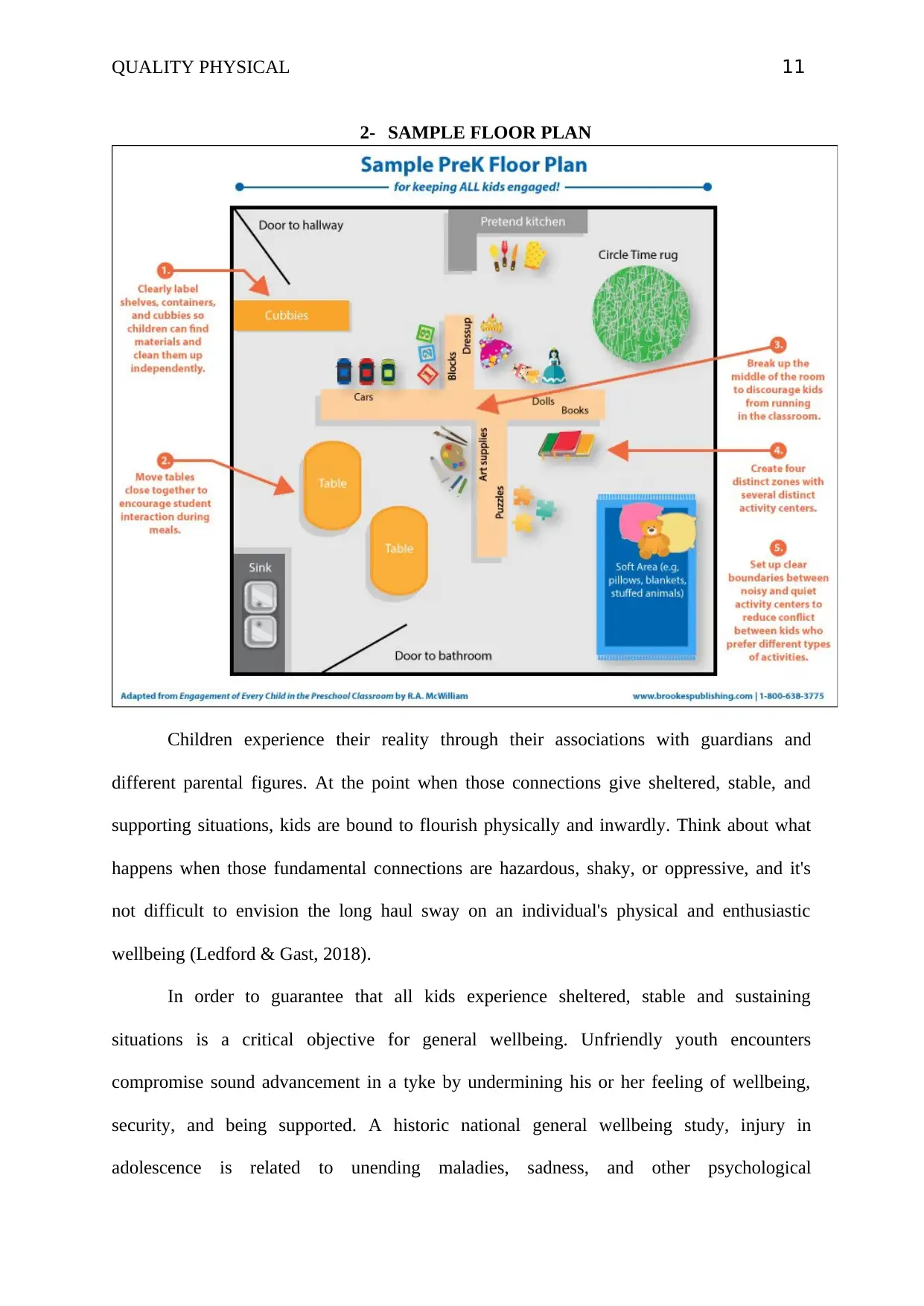
QUALITY PHYSICAL 11
2- SAMPLE FLOOR PLAN
Children experience their reality through their associations with guardians and
different parental figures. At the point when those connections give sheltered, stable, and
supporting situations, kids are bound to flourish physically and inwardly. Think about what
happens when those fundamental connections are hazardous, shaky, or oppressive, and it's
not difficult to envision the long haul sway on an individual's physical and enthusiastic
wellbeing (Ledford & Gast, 2018).
In order to guarantee that all kids experience sheltered, stable and sustaining
situations is a critical objective for general wellbeing. Unfriendly youth encounters
compromise sound advancement in a tyke by undermining his or her feeling of wellbeing,
security, and being supported. A historic national general wellbeing study, injury in
adolescence is related to unending maladies, sadness, and other psychological
2- SAMPLE FLOOR PLAN
Children experience their reality through their associations with guardians and
different parental figures. At the point when those connections give sheltered, stable, and
supporting situations, kids are bound to flourish physically and inwardly. Think about what
happens when those fundamental connections are hazardous, shaky, or oppressive, and it's
not difficult to envision the long haul sway on an individual's physical and enthusiastic
wellbeing (Ledford & Gast, 2018).
In order to guarantee that all kids experience sheltered, stable and sustaining
situations is a critical objective for general wellbeing. Unfriendly youth encounters
compromise sound advancement in a tyke by undermining his or her feeling of wellbeing,
security, and being supported. A historic national general wellbeing study, injury in
adolescence is related to unending maladies, sadness, and other psychological
⊘ This is a preview!⊘
Do you want full access?
Subscribe today to unlock all pages.

Trusted by 1+ million students worldwide
1 out of 16
Related Documents
Your All-in-One AI-Powered Toolkit for Academic Success.
+13062052269
info@desklib.com
Available 24*7 on WhatsApp / Email
![[object Object]](/_next/static/media/star-bottom.7253800d.svg)
Unlock your academic potential
Copyright © 2020–2025 A2Z Services. All Rights Reserved. Developed and managed by ZUCOL.




